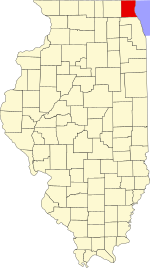Lake Villa Township, Lake County, Illinois
Lake Villa Township | |
|---|---|
Township | |
 Location in Lake County | |
 Lake County's location in Illinois | |
| Coordinates: 42°24′55″N 88°4′2″W / 42.41528°N 88.06722°W[1] | |
| Country | United States |
| State | Illinois |
| County | Lake |
| Established | 1913 |
| Area | |
| • Total | 26.1 sq mi (67.6 km2) |
| • Land | 22.8 sq mi (59.1 km2) |
| • Water | 3.2 sq mi (8.4 km2) |
| Elevation | 810 ft (250 m) |
| Population (2010) | |
| • Estimate (2016)[2] | 40,293 |
| Time zone | UTC-6 (CST) |
| • Summer (DST) | UTC-5 (CDT) |
| FIPS code | 17-097-41599 |
| Website | www |
Lake Villa Township is located in northwestern Lake County, Illinois. The population was 40,276 at the 2010 census.[3]
Geography[edit]
Lake Villa Township has a total area of 26.1 square miles (67.6 km2), of which 3.2 square miles (8.4 km2) or 12.47% is water.[3] Geologically, it is a region of glacial till, with numerous glacial lakes and wetlands. Principal lakes are Cedar Lake, Deep Lake, Crooked Lake, Sand Lake, Miltmore Lake, and Fourth Lake.
Cities and towns[edit]
- Antioch (small portions)
- Grayslake (small portion)
- Lake Villa (central areas)
- Lindenhurst (vast majority)
- Old Mill Creek (small parts)
- Round Lake Beach (north third)
- Round Lake Heights (north half)
Unincorporated areas[edit]
- Fox Lake Hills
- Ingleside (all parts east to Hazelwood Drive)
- Venetian Village
Adjacent townships[edit]
- Antioch Township (northwest, north)
- Newport Township (northeast)
- Warren Township (southeast)
- Avon Township (south)
- Grant Township (southwest)
Demographics[edit]
| Census | Pop. | Note | %± |
|---|---|---|---|
| 2016 (est.) | 40,293 | [2] | |
| U.S. Decennial Census[4] | |||
History[edit]
Lake Villa Township was created in 1913 from parts of Antioch, Avon, and Grant townships. Early settlements, long predating the creation of the township, included Monaville and Stanwood. In 1883, the Chicago businessman Ernst Johann Lehmann bought 300 acres (1.2 km2) in Stanwood, had the name changed to Lake Villa, and established the Lake Villa Hotel. Lehmann encouraged the Wisconsin Central Railroad Company to lay its new railway through the area, and in 1886 the new line opened with a station in Lake Villa. The Lehmann family would come to dominate the immediate area, for a time.
The railroad acted as a spur to enterprise beyond the farming which was the mainstay of the larger region. Resorting was the principal industry in the township into the 1930s. Prior to modern refrigeration, ice cutting drew seasonal labor.
The most important development following the Lehmann era was probably the creation of the village of Lindenhurst, subdivided by N. H. Engle and Sons in 1952 on the former Lehmann estate. The village was incorporated in 1956 and quickly became a force in the township.
Over the past decade the township landscape has become increasingly marked by subdivisions and strip malls, with a corresponding reduction in farm- and woodland. However, large areas of green space have been preserved by the Lake County Forest Preserves; units include Duck Farm, Grant Woods, Hastings Lake, and MacDonald Woods.
Government officials[edit]
- Township supervisor: Dan Venturi
- Township clerk: Jean K Smuda
- Township trustees: Glenn McCollum, Terry Beadle, Paul Berker, Barbara Stout
- Township highways: Jim Jorgensen
- Township assessor: Jeffrey Lee
Notes[edit]
- ^ "Township of Lake Villa". Geographic Names Information System. United States Geological Survey, United States Department of the Interior. September 1, 1995. Retrieved January 6, 2016.
- ^ a b "Population and Housing Unit Estimates". Retrieved June 9, 2017.
- ^ a b "Geographic Identifiers: 2010 Demographic Profile Data (G001): Lake Villa township, Lake County, Illinois". U.S. Census Bureau, American Factfinder. Archived from the original on February 12, 2020. Retrieved December 19, 2012.
- ^ "Census of Population and Housing". Census.gov. Retrieved June 4, 2016.
References[edit]
- Brysiewicz, Joseph W. Chicago's metropolitan fringe: Lake Villa, Illinois: the construction of multiple historical narratives. Lake Forest, Illinois: Lake Forest College, 2001.
- Brysiewicz, Joseph W. Lake Villa Township, Illinois. Chicago: Arcadia Publications, 2001.

